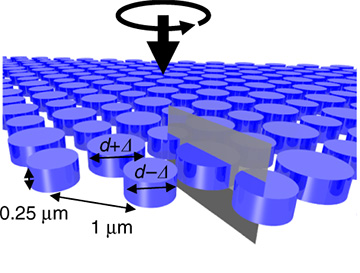
Simulation of the high-Q silicon metasurface (d = 640 nm). [Image: M. Lawrence and J.A. Dionne, Nat. Commun. 10, 3297 (2019), doi: 10.1038/s41467-019-11175-z; CC-BY 4.0]
To make tiny all-optical circuits on a chip, scientists will need to make light signals move in only one direction—seemingly in violation of symmetry principles. Two Stanford University, USA, researchers have developed the specifications for a near-infrared photonic diode that breaks this symmetry on the nanoscale (Nature Commun., doi: 10.1038/s41467-019-11175-z).
Breaking symmetry
Most materials that transmit electromagnetic waves exhibit time-reversal symmetry, a notion that originally came from thermodynamics but has important ramifications for optics. At everyday size scales and low frequencies, a magnetic field breaks this symmetry, but the trick doesn't work for optical frequencies and highly miniaturized devices. Faraday rotation could create the needed signal non-reciprocity, but not in the subwavelength regime. The nonlinear Kerr effect, which changes the refractive index of a medium due to an electromagnetic field, does work at subwavelength scales, but only with high-energy pulsed excitation.
Stanford researchers Mark Lawrence and Jennifer Dionne embarked on a different quest: to break time-reversal symmetry with all-optical stimulated Raman scattering. It had been done before in silicon waveguides, but only weakly.
Instead, the pair devised a silicon architecture that would exploit the spin selection rules of circularly polarized, Raman-amplified light to guide the near-infrared radiation. Lawrence and Dionne showed that a metasurface consisting of round silicon disks 640 nm wide and 250 nm thick, and with an array period of 1000 nm, “essentially acts as a light funnel” for a circularly polarized signal in the near infrared, they wrote. Such an architecture could serve as a subwavelength Raman amplifier in future circuitry.
Replacing electricity with light
The scientists also explored how stimulated Raman scattering could produce a plasmonic nano-antenna. They modeled a silver “bowtie” antenna, looking like four flat blades of a tiny windmill, with each arm 150-nm long. A diamond nanoparticle would sit in the center of the four blades. Computer simulations showed that the setup would exhibit one-way transparency to subwavelength radiation.
Of course, currently these tiny devices only exist in the realm of mathematical simulation. Still, Lawrence and Dionne hope that their explorations could lead to new nanoscale computer components, ranging from optical isolators to lasers to tunable photonic crystals.
